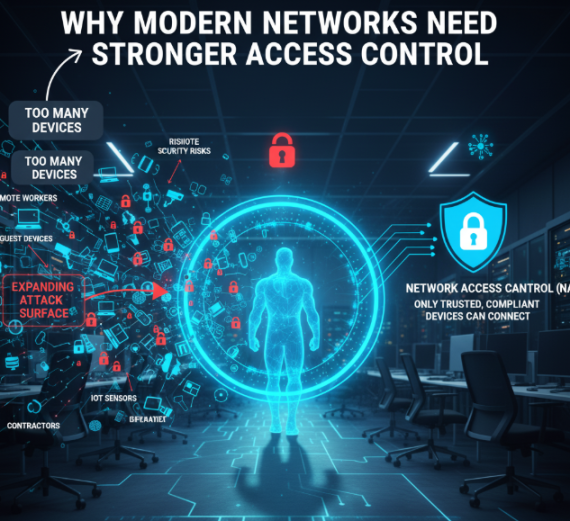Introduction: Why Modern Networks Need Stronger Access Control
As enterprise networks grow more distributed and hybrid, many IT teams face a familiar challenge: too many devices, not enough visibility or control. Between remote workers, guest devices, IoT sensors, and contractors, the attack surface expands faster than security teams can keep up.
This is where Network Access Control (NAC) comes in. NAC explained simply: it ensures only trusted, compliant devices can connect to your network — and blocks or quarantines everything else. For mid-market and enterprise organizations, NAC is now considered a foundational pillar of network security and Zero Trust.

What Is NAC? (Network Access Control Explained)
Network Access Control (NAC) is a security framework that controls which users and devices can access your corporate network. It evaluates every connection attempt based on:
- Identity (user authentication)
- Device posture (OS, patches, security tools installed)
- Role and policy (employee vs contractor vs guest)
- Network location (office, VPN, remote)
If a device fails any check, NAC can automatically:
- Block network access
- Place the device in a restricted VLAN
- Trigger remediation workflows
- Notify IT or security teams
Major frameworks like NIST Zero Trust Architecture emphasize NAC as a key control layer for verifying trust before granting access.
Why NAC Matters for Modern Network Security
A strong access control system does more than segment traffic — it reduces risk in critical ways:
1. Stops Unauthorized Devices
Shadow IT, rogue devices, and personal laptops create invisible entry points. NAC eliminates these blind spots by validating every device.
2. Enforces Compliance Automatically
NAC checks whether devices meet security standards (patches, AV, EDR) and blocks non-compliant ones.
3. Enables Zero Trust Network Architecture
You can’t implement Zero Trust without continuous verification — NAC provides this at the network access layer.
4. Helps Incident Response and Forensics
With clear device identities and logs, IR teams can trace threats faster.
5. Supports BYOD and IoT Safely
NAC creates separate access policies for personal devices, guests, contractors, and sensors.
NAC Deployment Best Practices
To get the most out of NAC, enterprises should follow a systematic rollout:
1. Start with Visibility Mode
Most solutions allow monitoring-only mode before enforcement. This minimizes disruption.
2. Define Clear Access Policies
Base policies on roles, device types, and compliance requirements.
3. Integrate with Identity & Endpoint Security Tools
NAC works best when connected to:
- Active Directory or Azure AD
- EDR/AV platforms
- MDM (Intune, Jamf)
- SIEM
4. Use VLAN Assignment for Segmentation
Automatically place risky or unknown devices into restricted networks.
5. Plan for Guest & Contractor Access
Provide secure onboarding that doesn’t introduce unnecessary risk.
Internal link recommendation: See how OmniLegion supports complex security projects on the IT support and engineering services page.
Real-World Use Cases
Organizations typically adopt NAC to solve problems like:
- PCI or HIPAA compliance requirements
- Mergers and acquisitions network consolidation
- Rapid IoT adoption
- Distributed workforce expansion
- Frequent contractor or vendor access
Gartner continues to highlight NAC as a core technology for Zero Trust edge security and hybrid workforce enablement.
For examples of similar deployments, visit OmniLegion’s IT transformation case studies.
FAQs About NAC
1. What does a NAC system do?
A NAC solution controls device access, verifies identity, checks security posture, and enforces network policies.
2. Is NAC required for Zero Trust?
While not the only requirement, NAC is a foundational component of verifying trust before granting access.
3. What’s the difference between NAC and firewalls?
Firewalls control traffic after a device is on the network; NAC controls which devices can get on the network in the first place.
4. Does NAC work with WiFi and wired networks?
Yes — NAC applies to both wireless and wired connections and can also integrate with VPN and remote access systems.
5. Is NAC difficult to deploy?
Modern NAC platforms from vendors like Cisco, Fortinet, and Aruba offer phased deployment options that reduce complexity.
Strengthen Your Network Security With Expert Guidance
If you’re planning to implement or upgrade a NAC solution, OmniLegion can help. Our engineering team supports everything from architecture and vendor selection to deployment and ongoing management.
Learn more or request support through our IT assistance page.

